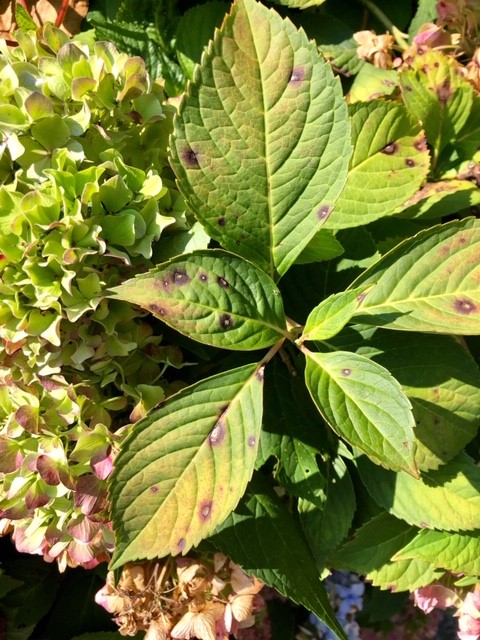Rumored Buzz on Hydrangea Leaves Turning Yellow
Table of ContentsHydrangea Leaves Turning Yellow Fundamentals ExplainedNot known Factual Statements About Hydrangea Leaves Turning Yellow Some Known Questions About Hydrangea Leaves Turning Yellow.Get This Report on Hydrangea Leaves Turning YellowThe Main Principles Of Hydrangea Leaves Turning Yellow Our Hydrangea Leaves Turning Yellow Statements
You can attempt to stop fungal illness by keeping your yards neat and free of particles. These leaves that will remain, waiting to attack in the following expanding season.These can be discovered at yard. Keep in mind to adhere to the instructions on the label of the fungicide you purchase. Copper fungicides are, yet if they are overused they can end up being hazardous to your plant. Eliminating infected leaves is additionally a terrific step. Clip the fallen leaves, and eliminate them from the garden.
If they aren't getting enough water, their leaves will brownish. Hydrangeas have a in the noontime sun, and jumping back when the sun has shifted and the plants have some time to recover. If this happens repeatedly you may observe brown and crunchy fallen leaves that are sagging. This is their way of allowing us know that it needs some additional moisture.

The Basic Principles Of Hydrangea Leaves Turning Yellow
Developed plants may require to be sprinkled one to 3 times per week, depending on your problems. It might seem appealing to spray the fallen leaves down.
Water the base of the plant,. As soon as the plant has actually recoiled, you can return to a regular watering schedule. Many varieties and ranges prefer partial sun. Panicle hydrangeas like full sunlight, however the remainder of the team really likes partial color. Partial color offers regarding four to six hours of sunshine.
The container should be large sufficient so the plant can expand and obtain all of the water and nutrients it requires. Place the container on a porch, or in an unethical area on a patio area. You can also replace the plant with a panicle hydrangea. Panicles enjoy the full sun.
No matter of the variety, strategy ahead and make sure your plant has plenty of security from the wind. You might transplant to a new area, or you can produce a wind barrier using another plant, or fence.
7 Simple Techniques For Hydrangea Leaves Turning Yellow
Decorative yard, Rose of Sharon, or Holly shrubs are simply a few concepts of plants you might use to obstruct the wind. If you need to transplant, locate an area in your yard that is well secured from sun and wind. Transplanting is ideal performed in the fall or the springtime.
The plants location is the most crucial factor when it comes to getting well-known and correct development. With a little planning on planting area and appropriate upkeep, you'll be able to ensure your hydrangeas!.
If Hydrangea leaves turn yellow and falls off later on, it's usually due to overwatering, as the plant can not uptake water and sheds the fallen leaves to reduce off transpiration. Following this, Hydrangea leaves start to droop and shrivel. Since both conditions can establish yellow fallen leaves, you should find here are the findings the distinction in between the overwatered and underwatered plant.
You can rescue the plant from yellow leaves by using it the proper light and positioning. If your plant obtains yellow fallen leaves, move it to a dark location. Location Hydrangea plants inside your home near an east-facing window. Dapple the plant with drapes or UV protection sheets to block direct heat.
The Single Strategy To Use For Hydrangea Leaves Turning Yellow
, and temperature changes can trigger yellowing leaves and brownish spots. If it obtains as well warm, the sides of the leaves come to be yellow, turn brown and create a crispy appearance.
Heavy dirt can quickly obstruct the oxygen supply to the origins and sever the connection with the top parts of the plant (fallen leaves). Hydrangea leaves change their shade if they locate minor hassles in the soil structure. This problem can trigger the Hydrangea leaves to turn yellow, deal with leaf declines, and make a sagging plant compatible overwatering.
However, yellow fallen leaves in Hydrangeas are the very first indicators of disease invasion, often adhered to by black spots, browning, goes down, and wilting. Isolate the unhealthy or pest-infested plant from the healthy and balanced plants to stop disease spread. If it is a yard plant, remove all the contaminated fallen leaves making use of sanitized devices and clean up all the debris.
Reducing off aids Hydrangea color unnecessary weight and protection, allowing the growth of new leaves. The very best time to trim Hydrangeas is springtime when the plant prepares to grow foliage for the next season. Check for invested or infected fallen leaves and reduce the base of a stalk that joins the leaves and stem.
Getting My Hydrangea Leaves Turning Yellow To Work
Avoid reducing healthy and balanced or green leaves, and do not get rid of greater than 25% of the plant's foliage. Collect the discarded entrusts to melt or compost them. The primary reason behind the red leaves in Hydrangea is poor dirt or ecological problems. If Hydrangea leaves have a white powdery material on them, it indicates Powdery Mildew infection.
Additionally, repot the plant yearly in spring or every 2 years if the development rate is slow.
There are six primary reasons that this could occur:: The plant does not obtain enough sunlight.: The origins are either as well damp or as well dry.: The plant is too cold.: The soil is not acidic or alkaline enough for the hydrangea.: The plant isn't obtaining the ideal nutrients it needs to remain healthy.
Each reason impacts the plant in a means that can be fixed if we comprehend how to care for hydrangeas the best means. When we talk regarding inadequate light for hydrangeas, we suggest that the plant isn't getting sufficient sunshine.
Some Known Incorrect Statements About Hydrangea Leaves Turning Yellow
Without sufficient sunlight, the leaves can turn yellow, the plant can end up being weak, and it may create fewer flowers. To make sure a hydrangea learn this here now receives appropriate light, it must be put in an area where it can enjoy the early morning light and be secured from the intense afternoon sun. Hydrangea Leaves Turning Yellow. Overwatering is when a hydrangea plant gets even more water than it requires

This issue prevails in the loss as the climate adjustments or if a hydrangea is grown in a place where it does not obtain enough warmth from the sun. It's important to know the right conditions for hydrangeas to stay clear of low-temperature anxiety. For instance, a lot of hydrangeas expand finest in zones 6 to 9, where the climate my sources is milder.

Comments on “The Best Guide To Hydrangea Leaves Turning Yellow”